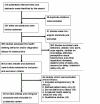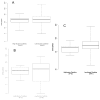Time delays in diagnosis of pulmonary tuberculosis: a systematic review of literature
- PMID: 19519917
- PMCID: PMC2702369
- DOI: 10.1186/1471-2334-9-91
Time delays in diagnosis of pulmonary tuberculosis: a systematic review of literature
Abstract
Background: Delay in diagnosis of pulmonary tuberculosis results in increasing severity, mortality and transmission. Various investigators have reported about delays in diagnosis of tuberculosis. We aimed at summarizing the data on these delays in diagnosis of tuberculosis.
Methods: A systematic review of literature was carried out. Literature search was done in Medline and EMBASE from 1990 to 2008. We used the following search terms: delay, tuberculosis, diagnosis, and help-seeking/health-seeking behavior without language restrictions. In addition, indices of four major tuberculosis journals were hand-searched. Subject experts in tuberculosis and authors of primary studies were contacted. Reference lists, review articles and text book chapters were also searched. All the studies were assessed for methodological quality. Only studies carried out on smear/culture-positive tuberculosis patients and reporting about total, patient and health-care system delays were included.
Results: A total of 419 potential studies were identified by the search. Fifty two studies qualified for the review. The reported ranges of average (median or mean) total delay, patient delay, health system delay were 25-185 days, 4.9-162 days and 2-87 days respectively for both low and high income countries. Average patient delay was similar to health system delay (28.7 versus 25 days). Both patient delay and health system delay in low income countries (31.7 days and 28.5 days) were similar to those reported in high income countries (25.8 days and 21.5 days).
Conclusion: The results of this review suggest that there is a need for revising case-finding strategies. The reported high treatment success rate of directly observed treatment may be supplemented by measures to shorten the delay in diagnosis. This may result in reduction of infectious cases and better tuberculosis control.
Figures



References
-
- World Health Organization (WHO) Global tuberculosis control, WHO report 2002. 2002. http://www.who.int/gtb/publications
-
- Toman K. Tuberculosis case finding and chemotherapy questions and answers. WHO Geneva; 1979.
-
- WHO expert committee on Tuberculosis: Ninth Technical Report Series 552. Geneva: WHO; 1974. - PubMed
Publication types
MeSH terms
LinkOut - more resources
Full Text Sources
Medical

